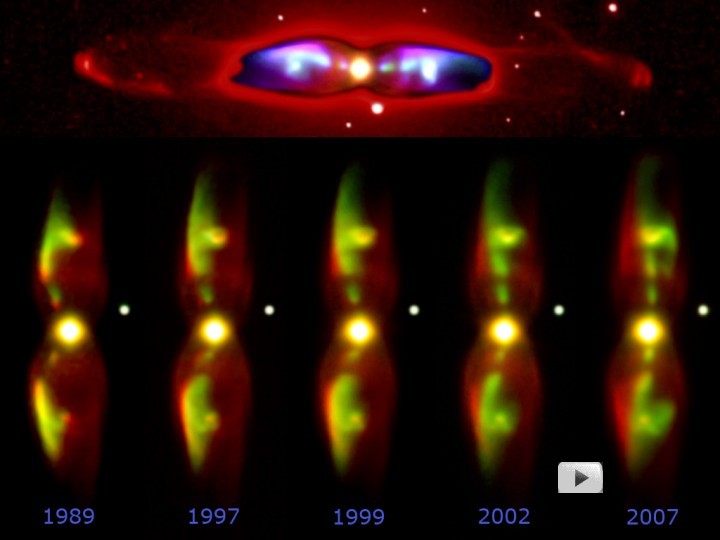Credit & Copyright: R. Corradi, M. Santander-Garcia
(Isaac Newton Group,
IAC),
Bruce Balick (U. Washington)
Explanation:
Exploring
the myriad shapes found in the
cosmic zoo of
planetary
nebulae, some astronomers have focused on the
intriguing example of M2-9.
About 2,100 light-years away and over one light-year across,
M2-9
is known as a twin jet or
butterfly nebula in reference to its
striking
bipolar symmetry.
Monitoring
M2-9 over many years from ground based telescopes
has revealed the dramatic west to east (left to right)
progression of features illustrated in this collage.
The apparent motion could well be caused by an energetic
rotating beam sweeping across the nebular material.
Astronomers argue
that the beam is collimated by interacting
stellar winds in a double star system at the center of M2-9.
The binary system of a
giant star and hot white dwarf
star orbit each
other about once every 120 years.
Click on the image to watch an animated gif of M2-9.
1999 2000 2001 2002 2003 2004 2005 2006 2007 2008 2009 2010 2011 2012 2013 2014 2015 2016 2017 2018 2019 2020 2021 2022 2023 2024 2025 |
Январь Февраль Март Апрель Май Июнь Июль Август Сентябрь Октябрь Ноябрь Декабрь |
NASA Web Site Statements, Warnings, and Disclaimers
NASA Official: Jay Norris. Specific rights apply.
A service of: LHEA at NASA / GSFC
& Michigan Tech. U.
|
Публикации с ключевыми словами:
butterfly nebula - planetary nebula - binary star - Планетарная туманность - туманность Бабочка - биполярные выбросы
Публикации со словами: butterfly nebula - planetary nebula - binary star - Планетарная туманность - туманность Бабочка - биполярные выбросы | |
См. также:
Все публикации на ту же тему >> | |
